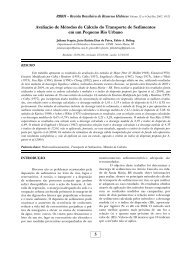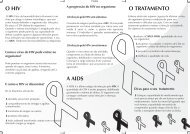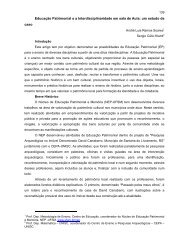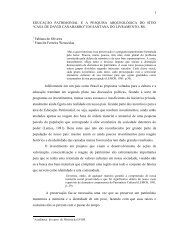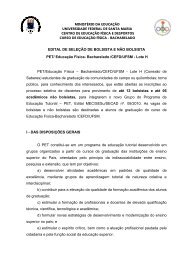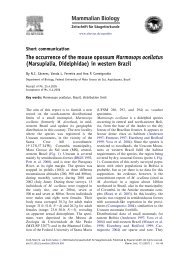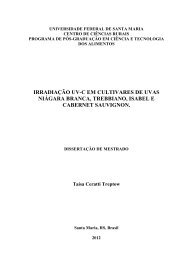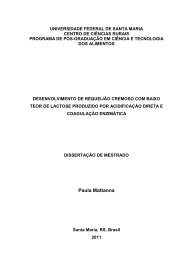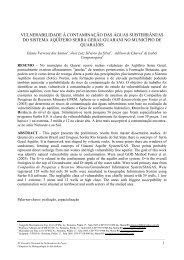Comparison of resin cement adhesion to Y-TZP ... - ResearchGate
Comparison of resin cement adhesion to Y-TZP ... - ResearchGate
Comparison of resin cement adhesion to Y-TZP ... - ResearchGate
You also want an ePaper? Increase the reach of your titles
YUMPU automatically turns print PDFs into web optimized ePapers that Google loves.
decyl phosphoric acid (MDP) monomers. The dilemma for<br />
the clinicians remains whether <strong>to</strong> follow the manufacturers’<br />
instructions <strong>of</strong> the <strong>cement</strong>s during <strong>cement</strong>ing the FPDs<br />
made <strong>of</strong> zirconia or modify the instructions and follow the<br />
instructions <strong>of</strong> some manufacturers that suggest separate<br />
surface-conditioning pro<strong>to</strong>cols.<br />
Therefore, the objectives <strong>of</strong> this study were <strong>to</strong> evaluate (1)<br />
the bond strength <strong>of</strong> four <strong>resin</strong> materials with various chemical<br />
compositions following the manufacturers’ instructions only<br />
and (2) <strong>to</strong> test their durability under dry and thermally aged<br />
conditions. The tested hypothesis was that thermocycling<br />
would decrease the bond strength <strong>of</strong> all <strong>resin</strong>s.<br />
Materials and methods<br />
Disc-shaped (diameter=15 mm, thickness=2 mm) Y-<strong>TZP</strong><br />
ceramics (LAVA, 3M ESPE, Seefeld, Germany) were<br />
embedded in polyethylene molds using polymethylmethacrylate<br />
(PMMA; Condular AG, Wager, Switzerland) with<br />
one side <strong>of</strong> the disc exposed for adhering the <strong>cement</strong><br />
(Fig. 1). They were ground finished up <strong>to</strong> 1,200-grit<br />
silicone carbide abrasive under water cooling and ultrasonically<br />
cleaned in distilled water for 3 min.<br />
The discs were randomly divided in<strong>to</strong> eight groups<br />
depending on the <strong>cement</strong> type and the ageing condition <strong>to</strong><br />
be applied (N=80, n=10/per group; Table 1). Four types <strong>of</strong><br />
<strong>resin</strong> materials were chosen: a light-polymerized (Panavia F<br />
2.0, Kuraray, Medical Inc., Osaka, Japan), self-adhering<br />
(Multilink Ivoclar Vivadent, Schaan, Liechtenstein) and<br />
chemically polymerized <strong>cement</strong> (SuperBond, Sun Medical,<br />
LTD, Tokyo, Japan) where the <strong>resin</strong> composite (Quadrant<br />
Posterior Dense, Cavex, Harlem, The Netherlands) acted as<br />
the control material.<br />
Fig. 1 The Y-<strong>TZP</strong> disc specimen was embedded in the PMMA with<br />
the <strong>cement</strong>ation surface exposed. Cement was applied incrementally,<br />
not exceeding 2 mm, <strong>to</strong> the surface using polyethylene molds (inner<br />
diameter=3.6 mm, height=5 mm) and polymerized accordingly<br />
Table 1 Testing groups considering the types <strong>of</strong> <strong>resin</strong> <strong>cement</strong>s and<br />
the s<strong>to</strong>rage conditions (dry vs thermocycling—TC)<br />
Type <strong>of</strong> <strong>resin</strong> <strong>cement</strong> S<strong>to</strong>rage condition a<br />
Panavia F 2.0 b<br />
Multilink c<br />
Superbond d<br />
Quadrant Posterior Dense e<br />
Shear bond test<br />
The specimens were placed in the jig <strong>of</strong> the universal<br />
testing machine (Zwick ROELL Z2.5 MA 18-1-3/7 Ulm,<br />
Germany), and load was applied <strong>to</strong> the adhesive interface<br />
until failure occurred (crosshead speed=1.0 mm/min). The<br />
maximum force <strong>to</strong> produce fracture was recorded (N/mm 2 =<br />
MPa) using the corresponding s<strong>of</strong>tware.<br />
Statistical analysis<br />
Dry Gr1<br />
TC Gr2<br />
Dry Gr3<br />
TC Gr4<br />
Dry Gr5<br />
TC Gr6<br />
Dry Gr7<br />
TC Gr8<br />
Clin Oral Invest<br />
Testing groups<br />
a Dry condition—Shear test was performed immediately after <strong>cement</strong>ation;<br />
TC condition—6,000 cycles between 5 and 55°C in deionized grade<br />
3 water. The dwelling time at each temperature was 30 s, and the transfer<br />
time from one bath <strong>to</strong> another was 2 s (Willytech, Gräfelfing, Germany).<br />
b (1) Conditioning the ceramic using chair-side air-particle abrasion<br />
device with 50 μm Al 2O 3 for 15 s making circular movements from a<br />
distance <strong>of</strong> 10 mm; (2) rinsing the surface for 20 s with water and air<br />
drying for 5 s; (3) mixing equal amounts <strong>of</strong> paste A and B from the<br />
Panavia F 2.0 with a <strong>cement</strong> spatula for 20 s; (4) application <strong>of</strong> the<br />
mixed <strong>cement</strong> in the polyethylene mould on<strong>to</strong> the ceramic surface<br />
incrementally; (5) light polymerization (light output=500 mW/cm 2 )<br />
<strong>of</strong> each increment for 20 s (Astralis ® 5, Ivoclar Vivadent AG, Schaan,<br />
Liechtenstein).<br />
c (1) Rinsing the surface for 20 s with water and air drying for 5 s; (2)<br />
applying Monobond-S on the ceramic surface with a microbrush,<br />
waiting 60 s and air drying; (3) application <strong>of</strong> the mixed <strong>cement</strong> in the<br />
polyethylene mould on<strong>to</strong> the ceramic surface incrementally (Ivoclar<br />
Vivadent AG, Schaan, Liechtenstein).<br />
d (1) Rinsing the surface for 20 s and air drying for 5 s; (2) applying<br />
the Porcelain Liner M <strong>to</strong> the surface with a microbrush; (3) Mixing<br />
four drops <strong>of</strong> Quick Monomer, one drop <strong>of</strong> Catalyst S and one small<br />
scoop <strong>of</strong> the <strong>cement</strong> powder with a brush; (4) application <strong>of</strong> the mixed<br />
<strong>cement</strong> in the polyethylene mould on<strong>to</strong> the ceramic surface incrementally;<br />
(5) waiting for polymerization for 6 min (Sun Medical Co., LTD,<br />
Moriyama, Japan).<br />
e (1) Rinsing the surface for 20 s and air drying for 5 s; (2) application <strong>of</strong><br />
the mixed <strong>cement</strong> in the polyethylene mould on<strong>to</strong> the ceramic surface<br />
incrementally; (3) light polymerization (light output=500 mW/cm 2 )<strong>of</strong><br />
each increment for 40 s (Astralis ® 5, Ivoclar Vivadent AG, Schaan,<br />
Liechtenstein; Cavex, Haarlem, The Netherlands).<br />
Two-way analysis <strong>of</strong> variance (ANOVA) and post-hoc<br />
multiple comparisons were used <strong>to</strong> analyze the data (SPSS<br />
for Windows Version 10.05; SPSS, Chicago, IL) with the<br />
shear bond strength as the dependent variable. p values less




